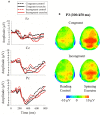Antecedent acute cycling exercise affects attention control: an ERP study using attention network test
- PMID: 25914634
- PMCID: PMC4391039
- DOI: 10.3389/fnhum.2015.00156
Antecedent acute cycling exercise affects attention control: an ERP study using attention network test
Abstract
The purpose of this study was to investigate the after-effects of an acute bout of moderate intensity aerobic cycling exercise on neuroelectric and behavioral indices of efficiency of three attentional networks: alerting, orienting, and executive (conflict) control. Thirty young, highly fit amateur basketball players performed a multifunctional attentional reaction time task, the attention network test (ANT), with a two-group randomized experimental design after an acute bout of moderate intensity spinning wheel exercise or without antecedent exercise. The ANT combined warning signals prior to targets, spatial cueing of potential target locations and target stimuli surrounded by congruent or incongruent flankers, which were provided to assess three attentional networks. Event-related brain potentials and task performance were measured during the ANT. Exercise resulted in a larger P3 amplitude in the alerting and executive control subtasks across frontal, central and parietal midline sites that was paralleled by an enhanced reaction speed only on trials with incongruent flankers of the executive control network. The P3 latency and response accuracy were not affected by exercise. These findings suggest that after spinning, more resources are allocated to task-relevant stimuli in tasks that rely on the alerting and executive control networks. However, the improvement in performance was observed in only the executively challenging conflict condition, suggesting that whether the brain resources that are rendered available immediately after acute exercise translate into better attention performance depends on the cognitive task complexity.
Keywords: alerting; executive function; interference control; orienting; spinning.
Figures





References
-
- American College of Sports Medicine. (2013). ACSM’s Guidelines for Exercise Testing and Prescription, 9th Edn. New York: Lippincott Williams and Wilkins. - PubMed
-
- Cereatti L., Casella R., Manganelli M., Pesce C. (2009). Visual attention in adolescents: facilitating effects of sport expertise and acute physical exercise. Psychol. Sport Exerc. 10 136–145 10.1016/j.psychsport.2008.05.002 - DOI
LinkOut - more resources
Full Text Sources
Other Literature Sources
Medical

